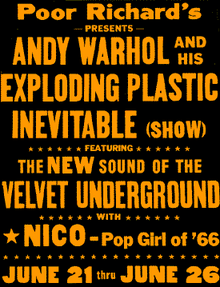Exploding Plastic Inevitable



The Exploding Plastic Inevitable, sometimes simply called Plastic Inevitable or EPI, was a series of multimedia gesamtkunstwerk events organized by Andy Warhol and Paul Morrissey in 1966 and 1967, featuring musical performances by The Velvet Underground and Nico, screenings of Warhol's films, such as Eat, and dancing and mime performance art by regulars of Warhol's Factory, especially Mary Woronov and Gerard Malanga. In December 1966 Warhol included a one-off magazine called The Plastic Exploding Inevitable as part of the Aspen No. 3 package.[1]
Andy Warhol's Exploding Plastic Inevitable is also the title of an 18-minute film by Ronald Nameth with recordings from one week of performances of the shows which were filmed at Poor Richard's nightclub in Chicago, Illinois, in 1966.
Background
[edit]In 1963, Warhol was part of a rock band called The Druds along with Patty and Claes Oldenberg, Lucas Samaras, Jasper Johns, Walter De Maria, La Monte Young, and Larry Poons. This project, albeit short-lived, demonstrates Warhol’s early engagement with performing music.[2]
The Exploding Plastic Inevitable had its beginnings in an event staged on January 13, 1966, at a dinner in the Delmonico Hotel for the New York Society for Clinical Psychiatry. This event, called Up-Tight, included performances by the Velvet Underground and Nico, along with Malanga and Edie Sedgwick as dancers[3] and Barbara Rubin as a performance artist.[4]
The first public EPI Happening, conceived of as a total immersion into a multimedia environment where the audience becomes part of the performance, was a 1966 month-long (April) performance at a Polish dance hall at 23 St. Marks Place in New York City called Polsky Dom Narodny. That space would later become the Electric Circus. The Exploding Plastic Inevitable was advertised in The Village Voice as follows: "The Silver Dream Factory Presents The Exploding Plastic Inevitable with Andy Warhol/The Velvet Underground/and Nico."[5] For it, Warhol and Paul Morrissey rented the Dom[6] from the two light artists, Rudy Stern and Jackie Cassen,[7] and had it painted white so that movies and slide projections could be cast on the walls in wallpaper-like fashion. Five movie projectors were utilized along with five carousel-type slide projectors which could each change an image every ten seconds. Slides were projected directly onto the films, whose sound tracks would sometimes be played, and thus blend in with the lengthy live atonal Velvet Underground improvisations and their dark, provocative songs like "All Tomorrow's Parties", "Heroin", "I'm Waiting for the Man", "Venus in Furs", and "Sister Ray".[8] A mirror ball also was utilized along with spot lights and strobe lights.[9]
E.P.I. shows, a barrage of flashing lights, multi-screened films, sadomasochistic mime, and noise music amplified into distortion, were later held in The Gymnasium in New York City and in various cities throughout Canada and the United States; including Chicago, Boston, Ann Arbor, Columbus, Ohio, Leicester, Massachusetts, Cleveland, Provincetown, Massachusetts, Los Angeles, and San Francisco where when sked to explain the Exploding Plastic Inevitable Warhol simply said that it's a totality.[10]
The Exploding Plastic Inevitable performed for the last time their sophisticated yet brutal mixture of film, art, loud music, hip fashion and new technology in May 1967, at Steve Paul's The Scene club in New York. [11]
Legacy
[edit]Andy Warhol's lights engineer Danny Williams pioneered many innovations that have since become standard practice in rock music liquid light shows. From May 27–29 the EPI played The Fillmore in San Francisco, where Williams built a light show including stroboscopes, slides and film projections onstage.[12] At Bill Graham's request he was soon to come back and build more. Film maker Jonas Mekas (who pioneered film projections during concerts at New York's Cinematheque), Andy Warhol and Danny Williams' influential ideas contributed much to the legendary Fillmore Auditorium's prestige and were also used at the Fillmore East and Fillmore West, both opening in 1968.
References
[edit]- ^ "From the research laboratories of Andy Warhol comes this issue of Aspen Magazine". Evergreen Review. 11 (46). April 1967.
- ^ [1] It Happened in 1966: Andy Warhol's Plastic Exploding Inevitable
- ^ Joseph, Branden W. (Summer 2002). "'My Mind Split Open': Andy Warhol's Exploding Plastic Inevitable". Grey Room. 8: 80–107. doi:10.1162/15263810260201616. S2CID 57560227.
- ^ Blaetz, Robin, ed. (2007). Women's Experimental Cinema: Critical Frameworks. Duke University Press. p. 143. ISBN 9780822340447.
- ^ Torgoff, Martin (2004). Can't Find My Way Home: America in the Great Stoned Age, 1945–2000. New York City: Simon & Schuster. p. 156. ISBN 0-7432-3010-8. OCLC 54349574.
the silver dream factory.
- ^ https://studsterkel.wfmt.com/programs/ingrid-superstar-gerard-malanga-paul-morrissey-and-sterling-morrison-discuss-exploding] ingrid superstar gerard malanga paul morrissey and sterling morrison discuss EPI
- ^ Warhol, A. and Hackett, P. 1980. POPism: The Warhol' 60s. London: Hutchinson, p. 156
- ^ [2] It Happened in 1966: Andy Warhol's Plastic Exploding Inevitable
- ^ Warhol, A. and Hackett, P. 1980. POPism: The Warhol' 60s. London: Hutchinson, p. 156
- ^ [3] It Happened in 1966: Andy Warhol's Plastic Exploding Inevitable
- ^ [4] It Happened in 1966: Andy Warhol's Plastic Exploding Inevitable
- ^ King, Homay (2014-11-25). "Moving On: Andy Warhol and the Exploding Plastic Inevitable". Retrieved 30 December 2019.
